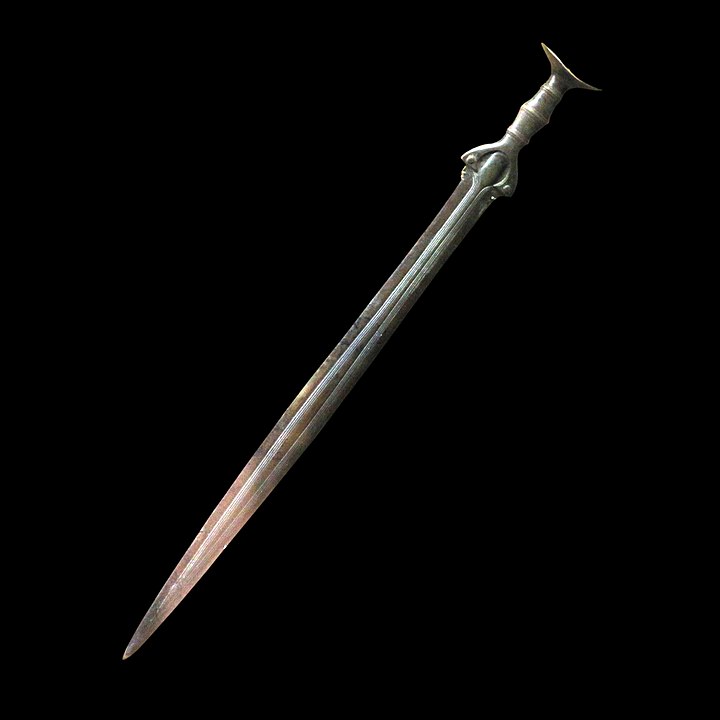
I learned this today. The Bronze Age started because people discovered that combining copper and tin made a stronger alloy called bronze.
In the three-age system of the world that we use, the Bronze Age technically follows the Stone Age and is in turn followed by the Iron Age. However, it isn’t quite that clear cut. It is not as though the Stone Age finished on the Friday and the Bronze Age began on the Saturday. There were elements of metalworking in the later Stone Age and some of the elements of the Stone Age continued on into the Bronze Age. The end of the Stone Age is estimated to be about 4000 BC.
Before the Bronze Age could begin, the process of smelting had to be discovered. Gold is the only metal that is found in its pure form in nature. All other metals are found as minerals that have to be reduced to their metal form. The minerals have to be roasted to make an oxide and then the oxides are heated and mixed with a reducing agent to leave the metal. This process is smelting.
Tin was the first metal to be smelted in about 6500 BC. Lead was discovered next, but it was too soft to really be of any use. Copper was the next metal to be discovered in about 5500 BC. There is a theory that this discovery was made by accident. Copper can only be smelted at about 1085℃, which is about 200℃ hotter than a regular fire can get. The discoverers may have used copper ore rich stones to line a pottery kiln, which can reach the necessary temperature. Copper is a very useful metal for making things, but it is quite soft and not very good for weapons.
In about 4200 BC, someone discovered that adding arsenic to copper made it stronger. This also might have been an accident because arsenic is sometimes an impurity in copper ore. The problem was, adding any more than about 2% arsenic to the copper made it brittle. This discovery was made by the Sumer people in the area that is now the Middle East and Turkey. About 700 years after this discovery, in about 3500 BC, they discovered that adding already smelted tin to the copper made an even stronger metal. The amount of tin had to be between 6 and 12 percent, but the resulting metal was strong and workable.
The knowledge of bronze making spread all over what is now Europe and Asia over the next thousand years or so.
The invention of bronze in Sumer enabled them to become a technological superpower of their age. They had bronze weapons that were stronger than anyone else’s weapons and they had bronze armor and helmets that couldn’t be penetrated by regular weapons. They were the first people to use daggers and swords. Swords weren’t possible with stone, tin, or copper. They can only be possible with a harder metal like bronze. Before the Bronze Age, people would have fought with rocks, spears, and bows and arrows made from flint or animal bone. They could make shields as well. The art of warfare was invented.
They also had bronze tools which enabled them to make things that other people couldn’t do. New trades were developed such as carpentry and boat making. Bronze tools gave them a level of mastery over wood that wasn’t possible before. The bronze axe allowed them to cut down more trees and wood became a more common material. They also started producing a lot of art and things they could trade.
Because tools and weapons were stronger, farming and hunting became more efficient. That allowed for a larger population and the first cities appear around this time. More people live together, which brings cultural changes. Writing systems and money were invented during the Bronze Age because when more people live together it is necessary to keep accounts.
The Bronze Age lasted until about 1200 BC when it was replaced by the Iron Age. Being able to create copper would have encouraged people to work with other metals and it was probably inevitable that iron would become possible one day. Once people learned how to make iron weapons and tools, bronze tools faded away. Bronze is harder than copper, but softer than iron. However, bronze as a metal never went away because it is easy to work with and has a beautiful appearance.
The transition from the Stone Age to the Bronze Age was very slow, but the transition from the Bronze Age to the Iron Age appears to have been very sudden and dramatic. It looks like it caused a cultural collapse for many civilizations that didn’t survive it. Nobody really knows why this happened. Cities were abandoned, trade routes vanished, and levels of literacy fell. And this is what I learned today.
Photograph by Rama, https://commons.wikimedia.org/w/index.php?curid=15473879
Sources:
https://en.wikipedia.org/wiki/Stone_Age
https://www.history.com/topics/pre-history/bronze-age
https://en.wikipedia.org/wiki/Bronze_Age
https://en.wikipedia.org/wiki/Bronze
https://en.wikipedia.org/wiki/Smelting
https://www.abc.net.au/science/articles/2015/03/31/4206279.htm
